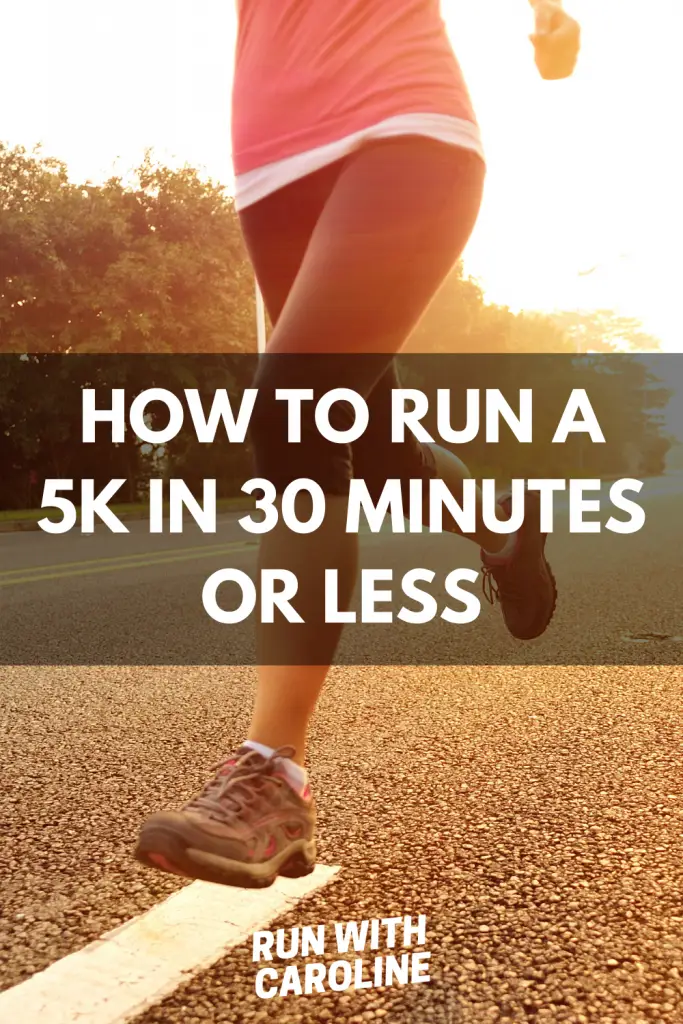Running a 5k is a key milestone for a lot of runners.
Although a 5k may not sound like a challenging distance, there are actually a lot of things to consider if you want to know how to run a 5k in 30 minutes or less.
Whether you’ve started running through the Couch to 5k programme, or you want to improve on your current 5k time, in this guide you will find some key tips on how to run a 5k in 30 minutes or less.
In this guide we’ll explore:
- How long is a 5k?
- How long does it take to run a 5k?
- Are you ready to run a sub-30 minute 5k?
- 30 minute 5k training plan
- 7 tips on how to run a 5k in 30 minutes or less
Ready?
Let’s get started!

How long is a 5k?
A 5k in miles is 3.1 miles. This is exactly half the distance of a 10k which is 6.2 miles.
Related: How many miles is a 5k?
How long does it take to run a 5k?
How long it takes you to run a 5k will depend on various factors, including your age, gender, fitness levels and running experience.
Even the weather and terrain can impact your race time.
Here are the average run times based on running ability:
- If you’re a beginner runner, you can expect to run a 5k in between 32 to 40 minutes.
- If you’re a novice runner, you can expect to run a 5k in between 27 to 33 minutes.
- If you’re an intermediate runner, you can expect to run a 5k in between 23 to 29 minutes.
- If you’re an advanced runner, you can expect to run a 5k in between 20 to 25 minutes.
- If you’re an elite runner, you can expect to run a 5k in between 18 to 22 minutes.
Related: Running 5 miles a day: Benefits + how to do it
Are you ready to run a 30 minute 5k?
In order to run a 5k in 30 minutes or less, you need to be running at a 30 minute 5k pace which is 9:39 minutes per mile or 6:00 minutes per kilometre.
When it comes to pacing, it’s important to maintain this type of pace consistently throughout your run.
This means you have to be able to run 9:39 minutes per mile or 6 minutes per kilometre for at least 30 minutes without stopping.
This may sound unachievable to you right now, but with the right training, motivation and mindset, you will be able to achieve your goal!
If you don’t think you’re quite ready to run a 30 minute 5k, then here are some other training plans that you could try:
Couch to 5k plan
The Couch to 5k training plan is a good starting point for anyone looking to build their endurance and stamina.
The plan uses a combination of running and walking intervals over a period of 9 to 12 weeks depending on the training plan you use.
This plan is a great starting point for many runners who then go on to run a sub-30 minute 5k.
Beginner 5k training plan
You may also consider a beginner 5k training plan.
Many beginner 5k training plans are between 8 and 6 weeks as it is felt this is an adequate amount of time to train for a 5k.
Intermediate 5k training plan
An intermediate 5k training plan is aimed at those runners who have run a 5k before and want to improve their 5k time.
This type of plan can last anywhere between 6 and 10 weeks depending on the race time that you are looking to achieve.
It also normally includes activities like speed training as these help you increase your speed and endurance which is very much needed when looking to improve your 5k race time.
Related: How to run for 30 minutes without stopping
Is a 30 minute 5k good?
Yes! Being able to run a 5k in 30 minutes or less is a huge achievement.
Many beginner runners complete their first 5k in between 30 to 40 minutes, so a sub-30 minute 5k is a fantastic time.
Related: How to run a 5k in 25 minutes or less

30 minute 5k training plan
A well-rounded 5k training plan will include runs and workouts that are designed to help you improve your endurance, speed and power.
The training plan will include:
- 1 to 3 easy runs
- 1 long run
- 1 speed training session
- 1 strength training session – e.g. interval training or tempo running
- 2 rest days
If you’ve never included these types of runs and workouts in your training plan, then now is the time to include them to help you run faster and achieve your desired race time.
Related: 30 day strength training plan for runner
Easy runs
An easy run should be run at a comfortable pace. Ideally, you should be able to hold a conversation without getting out of breath when you run.
You should include 1 to 3 easy runs in your training plan each week.
Each run should last at least 30 minutes.
Long run
The long run is the mainstay of any running training plan, no matter if you’re training for a 5k, 10k, half marathon or marathon.
Aim to include one long run in your training plan each week.
Each long run should be between 3 to 8 miles, gradually increasing in distance as the plan progresses.
Speed training
Speed training in the form of tempo runs and interval training is another key component to be able to run a faster 5k.
When practiced regularly as part of a structured training plan, speedwork can help to improve your speed, stamina and endurance.
Once you can run at a sustained pace for a period of 30 minutes or more, it’s advisable to introduce speed training to get used to running at a faster, sustained pace.
Here are some speed training examples that you could add to your training routine:
Tempo running
A tempo run, also known as a ‘threshold’ run, is when you run at a pace about 25 to 30 seconds slower than your 5k race pace.
The idea is that you should be able to hold a tempo run for roughly 20 minutes to reap the benefits.
For example, a 20 minute tempo run can be sandwiched between two easy runs during your training.
Interval training
Interval training is a training method that combines periods of short, intense bursts of running with slow recovery periods of mild activity like jogging or walking.
The intervals can be based on time or distance.
For example, you can either do 4 x 400m intervals or 4 x 1 minute intervals with walking or jogging breaks in between each interval.
Fartlek training
Fartlek is the Swedish term for ‘speed play’.
It is an unstructured form of speedwork which involves a continuous run in which periods of faster running are mixed with periods of easy running.
Similar to interval training, you can use either time or distance to measure the intervals of fast and easy running.
For example, you could run for one minute at a faster effort, then three minutes at an easy effort.
Alternatively, you could run faster for half a mile, then run easy for half a mile.
Some runners even use landmarks such as lampposts and street corners to measure intervals of fast and easy running.
Strides
Strides are short bursts of running at an accelerated speed.
As such, they are easy to include in your training plan as they can be done before a run as part of a warm up, in the middle of a run, or after an easy run.
To do strides, start with a jog then build up to about 95% of your maximum effort, then gradually slow to a stop.
One stride should take you about 25-30 seconds depending on your running ability.
Related: How to run faster: 6 secrets to increase your speed
Strength training
Strength training is probably the most neglected area of a training plan for many runners.
Many runners mistakenly think that strength training will make them bulky and therefore make them a slower runner which is untrue.
Strength training is so beneficial for runners because it helps to build stronger muscles and connective tissues.
This in turn helps you run more efficiently.
More importantly, strength training helps to dramatically reduce the risk of injury.
Studies have shown that strength training helps to prevent common running injuries like IT band syndrome, plantar fasciitis, shin splints and runner’s knee.
Just by incorporating one or two strength training sessions per week, these will go a long way to help you run faster.
Check out my 30 day strength training plan for runners for ideas and tips on how to incorporate strength training into your training.
Rest days
Rest days are important to allow your body to recover after each run and in between runs.
Don’t be tempted to run every day of the plan as you could risk burnout or injury.
Related: Strength training for runners: A complete guide

7 tips to run a 5k in 30 minutes or less
Now you know how to run a 5k in 30 minutes or less, here are some tips for making the most out of your training and choosing the right event to run your 5k (and hopefully a PB!)
#1 Choose a suitable course
If you’re looking to book onto an event to run your 5k, make sure you pick an event with a suitable course.
You’re more likely to run a sub-30 minute 5k on a relatively flat, even surface that doesn’t have any obstacles.
It also helps to run on a course that you’re familiar with.
#2 Wear the right gear
Ensure you are wearing running gear that you feel comfortable in.
The last thing you want is to keep adjusting your running leggings or running top as this will take your concentration away from your run.
Wear running gear that you are used to running in and ensure it is suitable for the climate you are going to be running in.
Check out my guide on finding the best affordable running gear.
#3 Wear the right running shoes
Equally, a decent pair of running shoes are a must.
There are so many things to consider when buying the perfect pair of running shoes – from foot arch types to gait and stability.
You will find that finding a pair of shoes is unique to you and how you run. There is no ‘one size fits all’ approach.
Check out my guide on how to choose the best running shoes for beginners for more information and tips on choosing the best running shoes for you.
#4 Warm up and cool down
The warm up before a run and a cool down after a run are really important when it comes to making the most out of your running performance.
Your warm up should focus on dynamic stretches to get your mind and body ready for the run, whilst your cool down should focus on static stretches to help your body recover after the run.
#5 Pace yourself
Pacing is a key component for any running distance – from 5k running to marathon running.
As explained at the start of this guide, you need to run at a pace of 9:39 minutes per mile or 6:00 minutes per kilometre.
If you’re new to pacing, use a running pace calculator to help you determine your race pace.
Pacing calculators work by taking your running distance and race time to calculate your pace.
You can also use GPS technology in the form of a GPS sports watch or a GPS running app to help you monitor your pace on your runs during training.
Proper pacing takes practice, so ensure you get into the habit of pacing during your training.
If you don’t get into a habit of regular pacing on your runs, you run the risk of running too fast or indeed running too slow.
Running too fast will quickly burn you out, and running too slow means your body won’t get used to running at a faster sustained pace.
#6 Refuel, rest and recover
Following a training plan can be quite demanding, especially when completed over a number of weeks.
Ensure you have enough time for adequate rest and recovery.
This means training smart and adopting a training strategy that prioritises rest and recovery. In other words, don’t feel like you have to train every day, every week.
Fuel your runs in the right away with proper nutrition and hydration.
Similarly, if you have a bad run, don’t let this get you down. There are ways to recover after a bad run and bounce back stronger.
#7 Cross train
Cross training is another effective way to become a faster and stronger runner and help you run a 5k in 30 minutes or less.
Many studies have shown that cross training improves the performance of athletes.
Cross training is all about incorporating a range of exercises and activities in your training plan in order to improve overall athletic performance.
Whilst running is great to improve your aerobic fitness and endurance, it’s not ideal to improve other components of fitness such as flexibility, power, balance, coordination and core strength.
Activities like walking, swimming, cycling and yoga are all considered cross training.
These types of activities should supplement your running but not replace it completely.
Therefore it’s recommended to try and include at least 1-2 days of cross training in your training plan.
Related: What is cross training? Essential cross training tips for runners
- 5 things I wish I’d known before returning to running - March 3, 2024
- Running 20 minutes a day: Benefits + how to start - January 27, 2024
- How to run your first 2 hour half marathon - January 16, 2024

sue
Thursday 4th of January 2024
Where is the running plan?
BuffDuck
Tuesday 22nd of June 2021
Long distance running is definitely another monster itself!